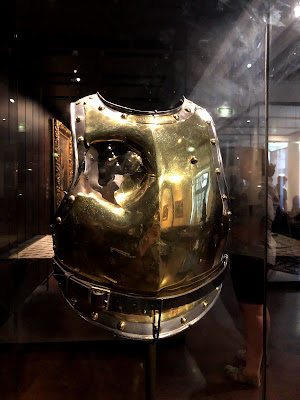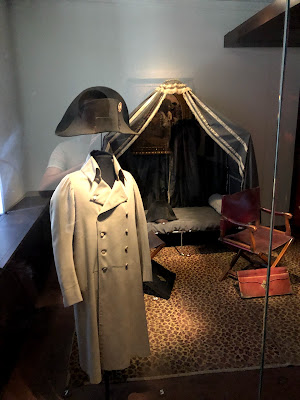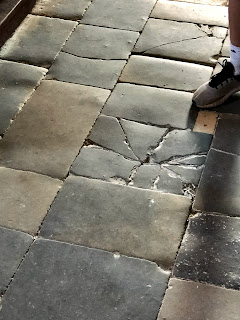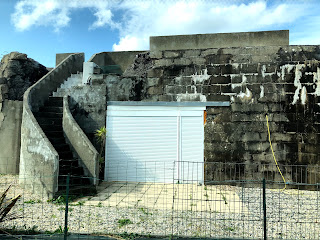A belated and longer post than anticipated, but I hope it's enjoyable
In early June, I headed to France for the 75th anniversary of the D-Day landings. I was invited by some of my reenacting buddies to participate in some commemorative events their group was doing with the modern-day regiment. It was going to be an extraordinary opportunity - so I couldn't say no.
My wife and I arrived in Paris, where we planned on spending the rest of the day and the first half of the next. Though this wasn't going to leave much time for tourism, we figured we'd hit some of the highlights (but in an effort to see as much as possible, decided to pass on spending out limited time in one or two of the city's famed art museums). As a Napoleonic buff, there were a few places on my "must-do" list! After checking into our hotel and grabbing lunch, we headed to Les Invalides to see Napoleon's tomb and and the French Army's museum.
 |
| Napoleon's Resting Place |
 |
| Carabineer body armor from the battlefield at Waterloo |
 |
| Napoleon's chapeau and greatcoat |
Even from a block away, I was completely blown away by the immense scale of the dome (Napoleon's tomb), so as soon bought our tickets, we headed to pay our respects to the emperor and some of France's other great military heroes - Vauban, Foch, etc. We then headed into the galleries of the army museum, where I was most interested in the displays from the black powder era and the World Wars. Overall, the museum houses an incredible collection of uniforms, weapons, and other artifacts, but I must admit I was underwhelmed with how the artifacts and the history of the army was presented. It was very much a "cabinet of curiosities" approach - lots of stuff, but very little in the way of interpretation and context. While I probably have an above average understanding of the Napoleonic Wars and the conflicts of the twentieth century, I struggled to fully appreciate the displays from some of the other eras that were not fully explained. Perhaps the audioguide would have helped, but more can definitely be done in the galleries to explain what the items are, how they are connected to these great moments in history, and how they help tell the story of France's warriors.
From the Invalides, we did some typcial Parisian touristy things and got our photos at the Eiffel Tower and the Arc d'Triumph. By this, it was getting into the early evening and we had already walked over 10 miles that day, so we headed back to the hotel and popped into a nearby bistro for a delicious meal.
 |
| One of the Parisian taxi cabs made legendary in the First Battle of the Marne |
 |
| WWII French motorcycle trooper uniform |
 |
| The Eiffel Tower |
 |
| Arc d'Triumph |

When planning the trip, we had hoped to spend time touring Notre Dame (and had gotten a hotel near the church), but due to its recent fire, we had to adjust plans. Thankfully the Île de la Citié has a number of other stunning attractions. So the next morning, we toured the gorgeous Saint-Chapelle, used the AR "Histopad" to learn about the layers of history in the Concierge (where enemies of the French state were long held), and spent some time to reflect on reasons for the D-Day landings at the Memorial to the Martyrs of the Deportation.
 |
| The cordoned-off Notre Dame |
 |
| Inside the Sainte-Chappelle |
 |
| Becca using the "Histopad" in the Concierge |
 |
| Marie Antoinette's cell, later turned into a chapel |
 |
| Map showing the departments from which the 200,000 deported French were taken |
Just before noon, we bid Paris adieu, took a cab to the airport, where we collected our rental car, and headed to Normandy. Since there were some foul ups at the rental car company, we left later than hoped and then we had some trouble finding our guest house, so by the time we got to Bayeux we didn't have enough time to visit the Battle of Normandy Museum and the Bayeux Tapestry as we had hoped. Ultimately, we settled on a quick visit to the Tapestry. Though we only got to see the artifact itself and not the film or museum, we were extremely pleased will the informative audio guide that took you through the story of the artwork.
After a delicious meal of local fare near the cathedral, I made a quick stop at the Bayeux British War Cemetery (my wife was feeling rather tired and stayed in the car). It was getting near close/dark and so I was the only one in the cemetery. Within a matter of moments, I really began to appreciate just where I was and the magnitude of the events we'd be remembering the next few days. I don't usually get over emotional, but was hit with a wave of sadness. As it was my first visit to a Commonwealth cemetery, I had not previously seen the personalized, family message that appear on many of the graves at cemeteries run by the Commonwealth War Graves Commission. They definitely helped humanize the sacrifices and the rows and rows of marble.
 |
| The grave of an American ex-pat killed while serving in the Northants Yeomanry |
 |
| The cemetery's Victoria Cross winner |
The next morning, we began our two days of touring the D-Day battlefields with
Overlord Tours. When we first started planning our trip, we knew we didn't want to lose time trying to navigate the unknown countryside ourselves, and private guides were largely booked for this busy weekend, so we booked two days of tours with the highest rated of the numerous companies offering guided, small group tours (and one of the few that offered tours of both the American and Commonwealth sectors). Our first day took us through the American sites, after a quick visit to the German battery at Longues-sur-Mer - where we received an excellent orientation to the Atlantic Wall. From there it was to Fox Green sector of Omaha at the famed German strongpoint WN62. It was surreal standing at a site so steeped in the lore of American military history and definitely made me fully appreciate the difficulties and horrors faced by the men who landed there.
Next was a quick trip up the bluff to the American cemetery, but since it was being prepared for the international commemoration ceremony on the 6th, we were only allowed to walk on the paved paths and could not walk among the graves, but it was still a moving visit. From the cemetery, we headed to nearby Point du Hoc, a site also run by the American Battle Monuments Commission. This was the first site we saw where you were really able to see the impact of the invasion, especially the Allied bombardment, as the landscape is still covered in craters. Though this was a busier site, our group was able to find a decent place to get an orientation and then had some free time to explore the German defenses. We also ran into do active-duty US Rangers were setting up ladders so they could follow in their forebearers footsteps by scaling the cliff later in the week!
 |
| At Longues-sur-Mer |
 |
| High Tide at Omaha |
 |
| Graves at the American Cemetery - the highlighted one in the foreground is that of Teddy Roosevelt, Jr. |
 |
| Shell craters at Point du Hoc |
 |
| Looking towards where the Rangers climbed |
After Point du Hoc we headed to Sainte-Mère Église, where we would have some free time for lunch and exploring. To describe the atmosphere and the crowds as "carnival-like" may have been generous, though we did notice that a temporary Ferris wheel had been erected. There were simply hordes of people crammed into the village center - tourists, guides, reenactors, active-duty American paratroopers - wandering in every direction through the museum, shops, restaurants, and food stands. Hoping that some of the lines for food would dissipate, we headed to the Airborne Museum first. Much like the museum at Les Invalides, it had an impressive collection, but many of the displays could use a thorough cleaning and a bit of an overhaul. The main building focusing on the assaults was quite nice, however, and the addition of a Histopad, like the one we had at the Concierge added a nice interactive component to the experience. Keeping an eye on the time, we went to go find food, and after standing in line for 25 minutes, scarfed down burgers and fries before rejoining the group in front of the village's famed church, were our guide, Thierry told us of the 82nd's landings and the fighting that in the heart of the town.
 |
| A depiction of the jump under a glass floor at the Airborne Museum |
 |
| The famed church at Sainte-Mère Église |
 |
| The bridge at La Fière |
 |
| Iron Mike - the airborne memorial at La Fière |
 |
| The field were the Brécourt Battery was located, the fourth gun was near where the people are on the right |
We continued our coverage of the American operations with a quick visit to the nearby La Fière Bridge, where we learned about the intense fighting there, the epitome of the many small unit actions fought be the beleaguered paratroopers against the German defenders. After a few photos there, we were back in the van, but not before an unplanned, but very appreciated drive-by of the Brécourt Manor site, made famous in
Band of Brothers. The property, still owned by the same family, is only opened to a few select tour companies. Though we didn't get out of the car (when we tried later, two big bus tours were there) and the trenches and gun emplacements have been long filled back in, it was cool to get to see the site - one on my bucket list I didn't expect to visit.
Next on the agenda was a brief stop at Utah Beach, where we saw some of the monuments and really got an appreciate for how stark the contrast between high and low tide can be on the Channel coast. While high tide at Omaha left maybe 25 or 30 yards of beach at Fox Green sector, on Utah at low tide, the water was barely visible off in the horizon - and the beach was filled with vehicles and farming equipment taking advantage of the tides to harvest shellfish. From Utah, it was onto our final stop - the church at Angoville au Plain - where two medics of the 506th Parachute Infantry Regiment, Bob Wright and Kenneth Moore, treated both American and German wounded for three days beginning on the evening of D-Day. The old church building is now kept as a memorial to these two brave men, both of whom frequently visited in the years after the war, and still bears the scars of the battle - including cracked floor tiles from where a German mortar bomb came through the roof but failed to detonate inside the church. When Wright passed away a few years ago, he was cremated, and his ashed were interred in the churchyard.
After this poignant stop, it was back to Bayeux where we had a quick visit to the cathedral, enjoyed another fine meal, and prepped and packed for another.
 |
| Panorama at Utah Beach |
 |
| The US Navy Memorial |
 |
| A quick photo op at the Dick Winters Memorial |
 |
| Inside the church at Angoville au Plain |
 |
| Section of the aisle damaged by a dud mortar round |
 |
| Memorial window in the church |
 |
| Yours truly with our exceptional guide of the American sector, Thierry! |
The next morning, we embarked on our tour of the Commonwealth section with another full van and our guide, Mathieu. Our first stop was Pegasus Bridge - the famed crossing captured by British gliderborne troops just a few minutes after midnight and held against stiff resistance all day. It was one of the places I was looking forward to visiting the most, having read and seen so much about the attack over the years. Seeing the bridges, both the modern copy that spans that Caen Canal and the original now on the grounds of the memorial museum, and the site of the pinpoint-precise glider landings was somewhat surreal. The museum had an excellent film (introduced by Prince Charles, the colonel-in-chief of the British Parachute Regiment) and a wonderful collection of artifacts, but much like the other museums we had visited so far, its displays were in need of some TLC and redesigning.
We then drove across Horsa Bridge, the other crossing point captured by those same glider troops and entered Ranville, a village liberated and defended by the paratroopers of the British 6th Airborne Division. It is the site of the Ranville War Cemetery, where the airborne soldiers, commandos, and others who fell in the defense of the Allied bridgehead across the Orne in the days and weeks after the landings are buried.
 |
| Plaque marking the site of the first glider and bust of Major Howard at Pegasus Bridge |
 |
| The modern bridge raised for canal traffic |
 |
| The German anti-tank gun at the bridge |
 |
| The original canal bridge on display at the museum |
 |
| Selfie at the bridge |
 |
| The grave of Lt. Brotheridge at Ranville - the first Allied soldier killed on D-Day |
 |
| The grave of Private Emile Corteil and his dog, Glenn - who jumped into France and was killed along with his master |
 |
| A grave of a member of the Army Catering Corps - given the nature of airborne operations, there are lots of support personnel buried in Ranville |
From Ranville, we headed to the Commonwealth beaches. First we stopped in the Orne River port of Ouistreham, the port of Caen, which was liberated by Free French commandos on D-Day. The memorials to these men, some of the most poignant we saw on our trip, display the incredible debt of gratitude the Norman people show these Allied soldiers most of all, most especially the flame of liberty inscribed with the names of all the French men who were in the spearhead of the liberation of their country. Next was Hermanville-sur-Mer, where we learned of the troubles faced by the men of the 3rd Division, who despite making a relatively easy landing met stiff resistance inland and were unable to secure Caen - their objective for the day. We also saw some memorials to some of the smaller Allied contingents that supported the landings - in this case the sailors of the Free Norwegian and Polish navies.
The rain begin to set in as we headed on to Juno Beach. We admired the large seawall at the beautiful resort town of St. Aubin-sur-Mer, where British commandos and the North Shore (New Brunswick) Regiment suffered heavily as they struggled to push in through the town and inland. Next was perhaps my most anticipated stop of the day - Bernières-sur-Mer where the Queen's Own Rifles of Canada and Le Régiment de la Chaudière landed. I've been reenacting the Queen's Own for fifteen years, so finally getting to stand where they fought and see where they took heavy losses, but still managed to clear the town and surge into the country was incredible - but more on that later! Next was a quick drive and stop at Colleville-sur-Mer, the landing site of the Royal Winnipeg Rifles and the Regina Rifle Regiment. The town is also home to the Juno Beach Centre - Canada's official D-Day museum, though we did not have time to visit this crowded attraction, but still had some time on the beach (which also marked the site of de Gaulle's return to France.
 |
| The flame of liberty honoring the Free French Commandoes who landed on D-Day |
 |
| Queen White Sector, Sword Beach - landing site of the 1st Battalion, South Lancashire Regiment |
 |
| 3rd Division Memorial at Sword |
 |
| German gun position at Nan Red Sector, Juno Beach (St. Aubin-sur-Mer) |
 |
| Queen's Own Rifles of Canada Memorial at Nan White Sector, Juno Beach |
 |
| Canada House (Maison de Queen's Own Rifles) |
 |
| Artwork on Mike Green Sector, Juno Beach - where the Royal Winnipeg Rifles landed |
 |
| A Churchill AVRE support tank on June |
Lastly, it was onto Gold Beach, where we visited the German defenses captured by Company Sergeant Major Stanley Hollis of the 6th Battalion, Green Howards at Ver-sur-Mer - actions that earned him the only Victoria Cross awarded for D-Day. Next was Arromanches, where we discussed the landings at Gold further and then saw the remains of the Mulberry harbor - the incredible floating harbor built by the Allies that served as their major supply hub on the Continent until Cherbourg, the Channel Ports, and Antwerp were finally secured and opened. Five-story concrete caissons were tugged across the Channel and sunk, floating docks built to adjust with the tides were installed, and for miles of floating roadways were constructed - a truly amazing feat!
 |
| The railway station/shed captured by CSM Hollis |
 |
| A bunker capture by Hollis, now turned into a bunker |
 |
| Gold Beach at Arromanches |
 |
| Concrete caissons from the Mulberry Harbor at Arromanches - Item Sector, Gold Beach |
We then headed back to Bayeux, bid our farewell to Mathieu, grabbed a delicious dinner in Bayeux, and then I dropped my wife off at the train station so she could head back to Paris for her return flight. I then drove onto my reenactment group's campsite to begin the next phase of the trip....but more on that later!
























































Excellent blog post and great photos. Very enjoyable reading experience.
ReplyDeleteThanks! I'll be posting the summary of the second half of the trip soon!
Delete